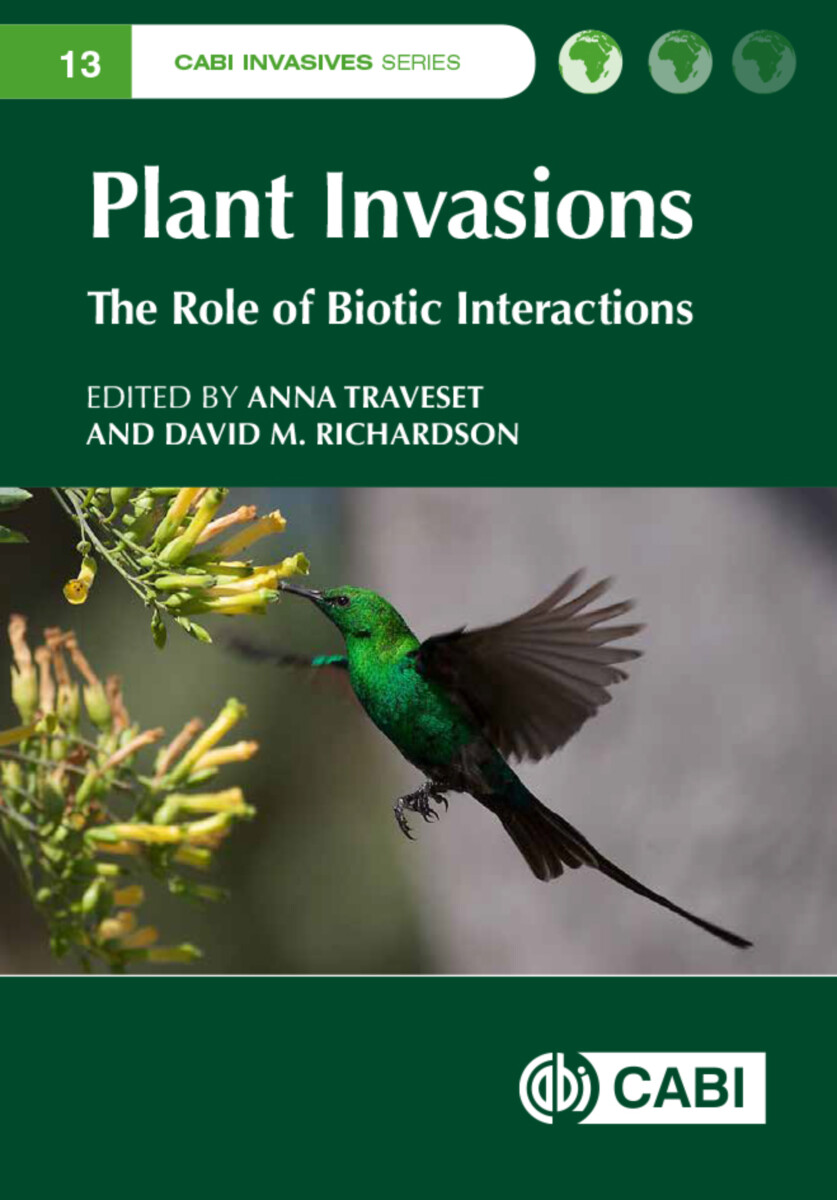- Publisher
CABI - Published
23rd December 2020 - ISBN 9781789242171
- Language English
- Pages 464 pp.
- Size 6" x 9"
Despite many books on plant invasions, none has focused on the role of species interactions. This book is a comprehensive overview of how plant invasions are mediated by varied species interactions and how such invasions influence this important component of biodiversity which involves the interactions (the "glue") among a community's species. Besides highlighting relevant findings, the book digs deeply into new methodologies to understand species interactions in plant invasions and how this can improve management of invaded communities. The book covers:
- Main theories/hypotheses in plant invasion ecology that invoke species interactions
- Plant invasions promoted by mutualistic interactions and release from enemies
- Antagonistic interactions preventing or hindering plant invasions
- Consequences of plant invasions on native species interactions and ecosystem functioning
- The interaction network approach to understanding plant invasions
- Importance of considering species interactions in managing plant invasions
Part I: Background
1: Plant invasions: the role of biotic interactions – An overview
2: The role of biotic interactions in invasion ecology: theories and hypotheses
Part II: Positive and negative interactions in the soil
3: Soil biota and non-native plant invasions
Part III: Mutualistic interactions that promote plant invasions
4: Pollination interactions promoting plant invasions-
5: Seed dispersal interactions promoting plant invasions
6: Ungulates as dispersal vectors of non-native plants
7: The role of plant-plant facilitation in non-native plant invasions
8: How direct and indirect non-native interactions can promote plant invasions, lead to invasional meltdown, and inform management decisions
Part IV: Antagonistic interactions that hinder plant invasions
9: Biotic resistance to plant invasions
10: EICA 2.0: A general model of enemy release and defence in plant and animal invasions
11: The role of pathogens in plant invasions
12: Direct and indirect effects of herbivores influencing plant invasions
Part V: Consequences of plant invasions for biotic interactions among native species
13: Impacts of non-native plants on plant-pollinator interactions
14: The effect of non-native plant invasions on seed dispersal of native plants
15: Allelopathic disruptions of biotic interactions due to non-native plants
16: Competition between native and non-native plants
17: Indirect biotic interactions between non-native plants and native plants and animals
Part VI: Novel techniques and experimental approaches in the study of plant invasions
18: How a network approach has advanced the field of plant invasion ecology
19: Molecular ecology of plant-microbial interactions during invasions: progress and challenges
Part VII: Biotic interactions and the management of ecosystems invaded by non-native plants
20: How can progress in the understanding of antagonistic interactions be applied to improve biological control of plant invasions?
21: Restoration of pollination interactions in communities invaded by non-native plants
22: Restoration of seed dispersal interactions in communities invaded by non-native plants
23: Multiple feedbacks due to biotic interactions across trophic levels can lead to persistent novel conditions that hinder restorationAnna Traveset
Anna Traveset is a Research Professor of the Spanish Research Council based at the Mediterranean Institute of Advanced Studies in Mallorca, Balearic Islands, Spain. Her research focuses on species interactions, mostly on island ecosystems, and how these are influenced by different drivers of global change. She has published more than 200 papers in scientific journals and as book chapters, and has edited several special issues, one in Journal of Biogeography (2012) and the other in AoB PLANTS (2015). She belongs to the editorial board of five scientific journals. In 2017, she was awarded the Prize King Jaume I in the category of "Environmental Protection."
David M. Richardson
David M. Richardson was Director of the DSI-NRF Centre of Excellence for Invasion Biology in South Africa between 2011 and 2022. He is currently a Distinguished Professor in the Department of Botany and Zoology at Stellenbosch University, South Africa. His research focuses on biological invasions, mainly plant invasions. Dave is author or co-author of over 500 journal papers and book chapters and several books, including Invasion Dynamics (Oxford University Press, 2017) and Invading Ecological Networks (Cambridge University Press, 2022). He has edited or co-edited nine books, including Ecology and Biogeography of Pinus (Cambridge University Press, 1998), Fifty Years of Invasion Ecology (Wiley-Blackwell, 2011), Biological Invasions in South Africa (Springer, 2022) and Plant Invasions: The Role of Biotic Interactions (CABI, 2022). He was Editor-in-Chief of the journal Diversity and Distributions between 1998 and 2015. Dave was awarded the Hans Sigrist Prize for 2006 by the University of Bern, Switzerland, in 2012 received the John F.W. Herschel Medal, the senior medal of the Royal Society of South Africa, and in 2019 was recipient of the African Union's Kwame Nkrumah Award for Scientific Excellence (Continental). Most of his work on this book was done while he was on sabbatical leave with support from the Institute of Botany of the Czech Academy of Sciences in Prague, Czech Republic.


